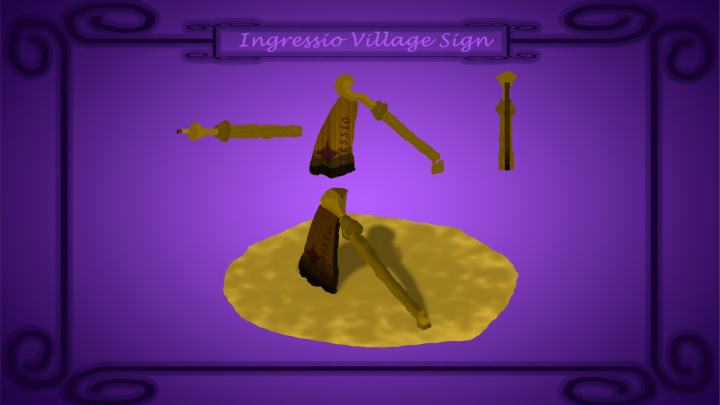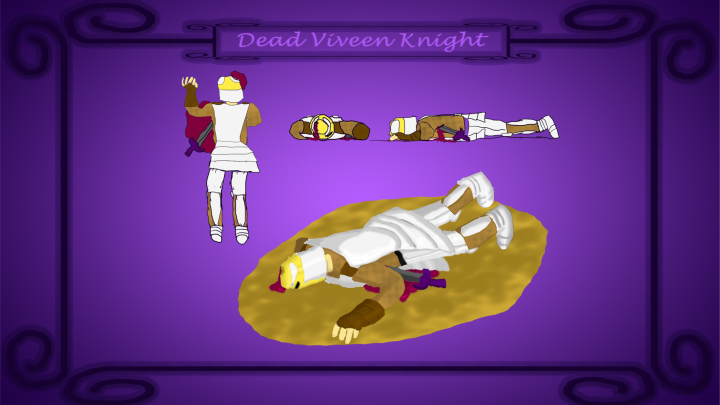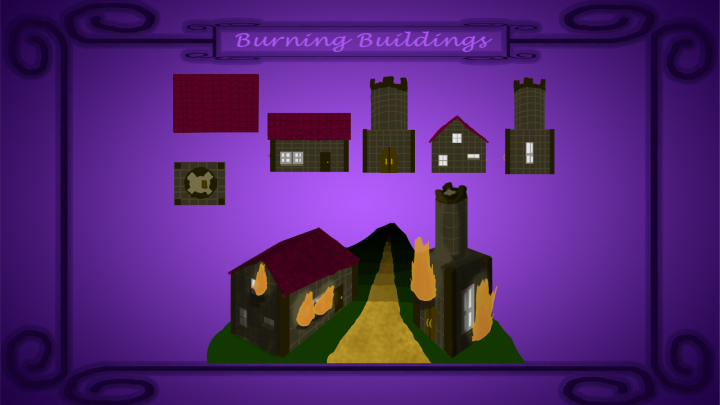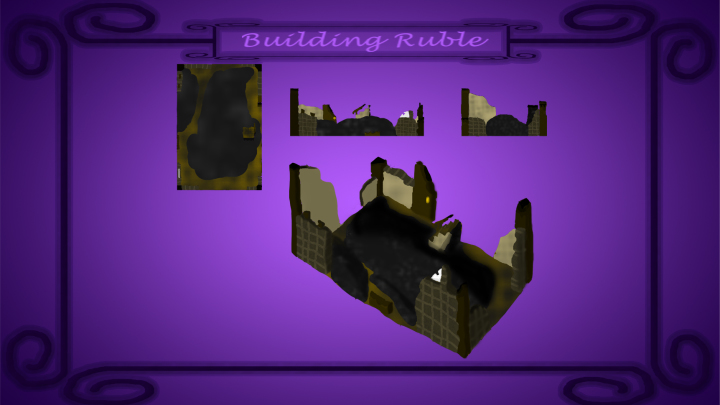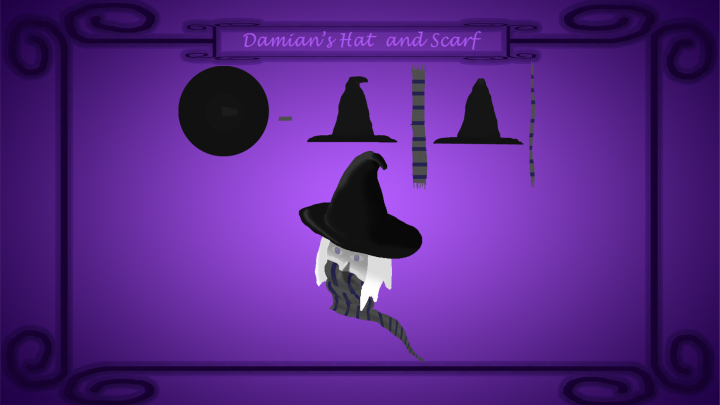Category Archives: Work
Burning Hometown Orthos (Darkling)
This is a digital painting project I did involving my game idea, “The Darkling”. These are objects for a scene I hope to eventually model and animate on my own, so years ago when I made these images as classwork, I tried to be very specific with some of the details and the orthographics.
- Destroyed sign that would be at the village entrance.
- A dead soldier of the invading army, based on a crusader as they are an army of “light”.
- Buildings that were set on fire by the invading army
- Destroyed remains of a house.
- The main character, Damian.
- Damian’s hat and scarf are important parts of both his design and story.
BattleBot

BattleBot, my first full humanoid rig animation with a fighting robot.
As the final project of one of my animation classes, we were tasked with making a humanoid robot with rigid bound joints and animate them doing something. While my environment wasn’t as detailed as others with the project, I decided to add more visual effects in post and a second humanoid robot.
Claw 2

Claw 2, an animation exercise with a rigged, IK object.
Another animation exercise, this time we were told to make a claw machine and animate it using our own rig set up with IK joints. Running off the success of my sack animtion, I made the claw a bit more complex by giving it an eye as well and bringing the sack in as part of the joke in the animation.
Sack Animation

Sack Animation, the first time I worked with a rig putting a sack character through deadly traps.
This was one of my first larger animations despite being just an exercise in how to animate with a rig. We were given the sack with a full rig built in and told to animate it accordingly. I took this a fair bit farther, giving the sack a face through animating a texture and putting it through a deadly obstacle course.
Camelisk Spizard

Camelisk Spizard, an organic modeling hybrid of a camel spider and basilisk lizard.
This project was the final exam for Organic Modeling. We had to not only create our own creature, but also model it in a way that would allow for animation and realistic movement. Basically, the creature couldn’t just be haphazardly thrown together, instead we had to really think of how it would live. This fast little nightmare would be quite the predator, especially as it can run across water.
Spooky Spawner – Final Update

Thought I’d give one last update on the unity project I had been working on for that class. As you can see above, it’s quite spooky. The reason all the models are so simple is because everything that is spawned (as in, not the background or tombstones) are procedurally generated. even the animations and particles have code affecting the way they show up.
Spooky Soundboard Update
I handed in my Halloween Unity assignment thing.
I’m sure that went wonderfully.
Well… It wasn’t really a soundboard in the end. I really just barely hit the criteria as I had a program with a small room where you could click to spawn pumpkins, skulls or bats, then press a button and have them animate with sound.
That doesn’t sound too bad really.
Eh, there were some that were much better though. Anyways, this weeks assignment is to expand on that project with particle systems.
… Oh don’t tell me.
I’M GONNA TEAR DOWN THOSE WALLS AND MAKE A HUGE HALLOWEEN-Y SCENE! With bat sims in the distance and fire for the pumpkins and everything.
Can’t wait to see how badly this one crashes.
How to Use a Shield to Kill a Beast
For my senior project, our group had been having some issues thinking of creative ways to use a shield. As such, I was assigned with figuring out some puzzle mechanics that could be worked around with access to a decent sized shield. The shields only functions are to block in the direction of the player and to let the player slide along the ground.
Here’s what I came up with so far:
- Directional Blocking: Fairly straightforward. The shield would block an incoming object, causing it to bounce off at a specific angle from the shield. This object could be some part of a larger puzzle such as a boulder, or something dangerous like one of our creatures.
- Plugging Up Stuff: Again, just as it says on the tin. Say there’s some kind of stem shooting out of the wall. The shield would allow the player to press their body against the hole and plug it with greater force and without burning themselves. This could, in turn, lead to even more steam based action as the steam tries to find another way out.
- Sliding On Dangerous Terrain: Such as off a cliff or through a dangerous substance.
- Riding On Dangerous Terrain: Put together 2 and 3, get launched up by some kind of eruption and survive.
- Making A Quick Escape: imagine you trigger a set of events that wind you up on a large sloped pillar of stone and that stone starts to fall apart. Well, now you’re going to have to slide down, because running isn’t going to work.
Rather than a tool solely for puzzle solving, the shield is much more multipurpose and heightens the action of the game while providing a bit more puzzle depth.
An Excerpt from My New Media Paper
These were the concluding paragraphs to the paper I wrote last term on the future of augmented and virtual reality. This paper was part of the inspiration for my augmented reality thesis idea.
Imagine a hypothetical future wherein these technologies have both greatly developed. Joe gets up in the morning and starts getting ready for school. While doing this, he gets an update on his favorite news sites and email through images transmitted directly to his view by augmented reality technology. He goes to school and is taught with the newest technology, allowing for an interactive experience with digital objects that give a better understanding of the subject. On his way home, his friends contact him, getting in contact as if they’re right next to him despite being in a different country. They invite him to meet up later at the usual place. After getting home and doing whatever work he has to, again with the help of digital technology, Joe kicks back and grabs for a special visor. Before he knows it, he’s in a virtual world, surrounded by bustling townspeople. There, he meets up with his friends’ avatars and they go off to explore the latest area added to the ever expanding virtual horizon.
This could very well be the future with the rate different reality technologies are going. Augmented reality is poised to continue to improve our day to day life and interactions, in essence trying to perfect our own reality. Meanwhile, virtual reality, with its more personal focus on escaping our reality and new possibilities of networking through companies such as Facebook, has the potential to surpass the modern internet. Web2.0 was marked as a stride forward in web design when it added new interactivity and freedom of design options, so virtual reality could possibly take that a step further, becoming a possible Web3.0 wherein we are actively immersed in the web. Augmented reality making our world a better place while virtual reality creates a whole new world of nearly endless possibilities. That just one of the possible futures with the rapid advancements in these technologies. Of course, such radical changes will come with their own breadth of ethical and moral issues, from the problems of overuse of VR to the invasive properties AR could have. These just mean that as these technologies emerge, society must keep a constant eye on them and their changing environments. As long as attention is paid, these technologies seem like they will lead to very bright, promising futures.


